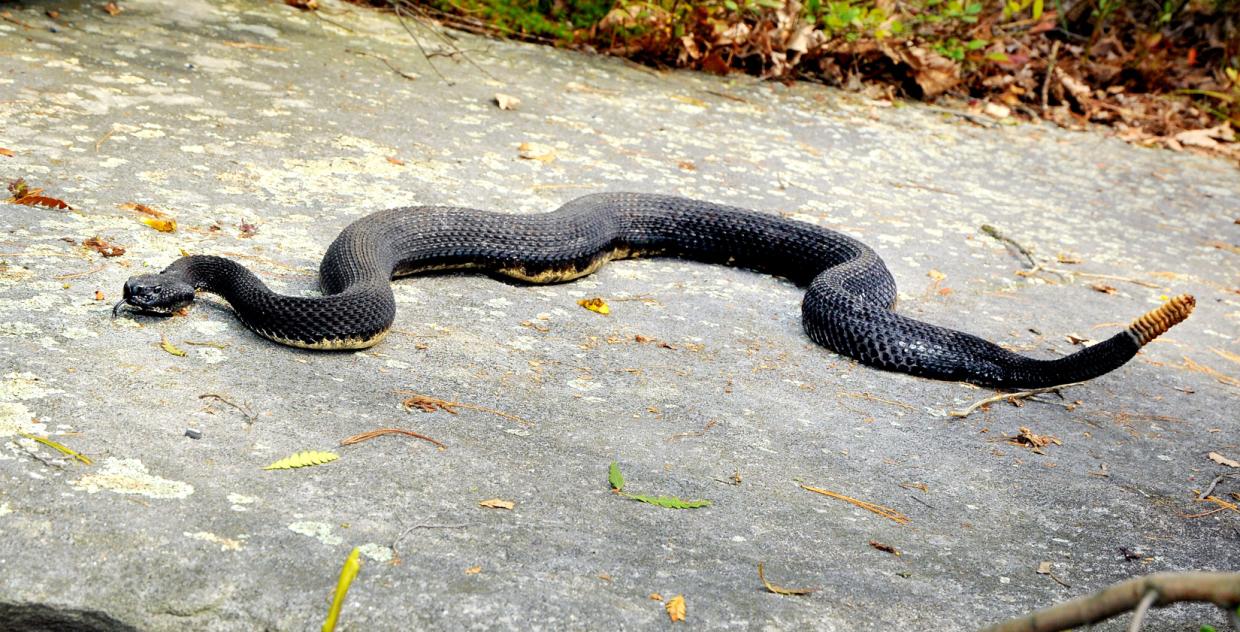Agency Mission
The conservation of Massachusetts’ native fauna and flora is the statutory responsibility of the Division of Fisheries and Wildlife (MassWildlife). MassWildlife’s specific charge is the stewardship of all wild amphibians, reptiles, birds, mammals, and freshwater and diadromous fishes in the Commonwealth, as well as endangered wildlife including native wild plants and invertebrates.
Statewide Status of the Timber Rattlesnake
The Timber Rattlesnake (Crotalus horridus) is a native species to all six New England states, having colonized from the south as far as the White Mountains and Lake Champlain during a warm period following the glacial retreat. In Massachusetts, the Timber Rattlesnake was formerly widespread and locally abundant in Essex, Middlesex, Worcester, Suffolk, Norfolk, Franklin, Hampshire, Hampden, and Berkshire Counties until the late-19th century. Today the Timber Rattlesnake is one of the most endangered species in Massachusetts, having sustained the largest decline of any native reptile species in the past 150 years. Geographic place names, town histories, historical scientific reports, and museum specimens demonstrate a clear pattern of rapid, statewide range contraction from the mid-1800s to the early 1900s. During the early colonial period, the Timber Rattlesnake evidently was widespread on many mountainous areas of bedrock exposure, absent only from Cape Cod and the Islands and the highest elevations of the Worcester and Berkshire Plateaus. Timber Rattlesnake populations across Massachusetts had mostly collapsed by the late-19th century as a combined result of widespread deforestation and eradication efforts, the latter supported by a bounty system. During the same time, the Timber Rattlesnake disappeared from Maine and Rhode Island and was reduced to a single site in New Hampshire and two sites in Vermont. At least two Massachusetts populations were extirpated in the past 50 years. There are only five remaining populations in Massachusetts, at least two of which are at very high risk of imminent extirpation caused by a combination a diverse array of factors and threats, which have proven extremely difficult to alleviate, and the conservation outlook for these populations is extremely dire. Timber Rattlesnakes have been a species of conservation concern for over 40 years and are protected in Massachusetts through the Massachusetts Endangered Species Act (MESA) since 1990.
Threats to Remaining Rattlesnake Populations
Threats to Timber Rattlesnakes within existing sites in Massachusetts vary in significance among the five remaining populations. Major threats include vehicle mortality caused by automobiles and ATVs; incidental and purposeful killing; harassment by curiosity seekers; collection by poachers; increased use of new and unsanctioned trails and of certain vistas. Rattlesnakes populations are further threatened by natural sources of mortality and an emerging, episodic fungal pathogen.
Statewide Conservation Strategy for Rattlesnakes
To directly address known threats and to ensure the persistence of the remaining populations, MassWildlife continues to work intensively with key partners—including the Department of Conservation and Recreation, Department of Transportation, Environmental Police, land trusts, private landowners, and scientists—to identify the most critical threats and to prioritize and implement the most necessary and urgent conservation actions. Critical conservation actions include working with partners to: protect key parcels of privately-owned land; reduce public access to sensitive den/basking/birthing areas; reduce road mortality through seasonal evening road closures; improve outreach to towns with rattlesnake occurrences (including neighboring landowners); strengthen law enforcement efforts; and increase monitoring following standardized protocols. At the most critically imperiled sites, steps are being taken to increase juvenile survivorship to help offset unnatural rates of excessive adult mortality. These actions are implemented by a network of conservation partners coordinated by MassWildlife. Given the dire threats that rattlesnakes in Massachusetts are facing, continued efforts will be needed if we hope to ensure the continued existence of the species in the Commonwealth.
Additional Resources
Contact for Rattlesnake Conservation in Massachusetts
Online
Phone
Open M–F, 8 a.m.–4 p.m. (closed noon–12:30 for lunch)
North/Central/Western Massachusetts
Southeastern Massachusetts/Cape & Islands
